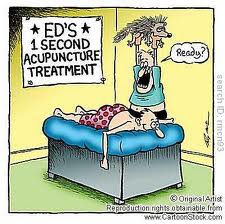Misconceptions About Pain – Grinning and Bearing It!
Author: Michael Douglas
Doctors differ in how they deal with pain. Older ones – of the family doctor variety who have a lot of experience in treating a variety of non-life-threatening injuries and illnesses – often dismiss pain with a hearty, “You’ll feel better soon.” Younger specialists, who have to fight much harder to earn their livelihoods and are also more materialistic, are much more solicitous of their patients’ comfort and prescribe painkillers as easily as they would offer a child sweets.
But on the whole doctors tend to under-treat pain. There is a feeling that pain is just a fact of life. It accompanies all illnesses and it has to be borne. There is also the fear – both among doctors and among patients – that if painkillers are taken too often, they could become a habit.
But, as doctors are realising, pain can take a heavy toll on a patient’s health and spirits. Compared to this, the risk of becoming addicted to painkillers is small. OTC (or over the counters) drugs are medicines that can be bought without a prescription and can relieve pain quite miraculously if they are used before the pain becomes really bad. And if one medicine does not work, a stronger one can be tried.
But does this mean that OTC medicines can be popped as nonchalantly as we pop chocolates into our mouths? Many people think that they can, but they are wrong. In fact, there are many misconceptions about pain. Here are the myths and the true facts about them.
Misconception 1. If pain goes away with OTC medication, it cannot be anything serious.
This is not true. Your response to OTC medicines has nothing to do with the seriousness of your medical problem. A sprained ankle is definitely not life-threatening, but the pain can be excruciating and may not respond to OTC medicine at all. On the other hand, serious illnesses like cancer or strokes may cause so little pain (at times) that OTC medicines work fine for patients.
So when do you take pain seriously? A rule of thumb is that minor ailments, even if the pain is agonising at first, normally heal or get much better in a week. They also don’t come on very suddenly. You should see a doctor if the condition does not improve, if the attacks of pain are sudden and strong and if OTC medicines do not work at all.
Misconception 2. Women deal with pain better than men do.
Actually, research has proved that neither sex is better in dealing with pain per se. There are different kinds of pain and men and women deal with them differently. Women are able to deal better with chronic pain than men are, but men can deal better with sudden, acute pain – like when you hit your thumb with a hammer or touch something very hot.
Women, however, recover from pain quicker than men do. So in the case of, say a tooth extraction, women suffer more initially, but are less bothered by the lingering discomfort over the next few days.
Research on people suffering from osteoarthritis has given a reason for this ability of women to deal with chronic pain. They cope because they complain to friends, seek support, pray and ask their doctors for help. So they get emotional support and this helps them. Men, on the other hand, try to grin and bear it, to keep up their macho image and, as a result, they do not cope as well.
Misconception 3. Breast cancer does not cause pain.
It is true that breast cancer doesn’t cause pain in the initial stages, but this does not mean that if something is causing you pain in your breast, it cannot be breast cancer. Certain uncommon types of breast cancer can cause pain – for example, cancer that affects the skin and lymph glands in the breast.
But generally, tenderness in the breast is nothing to worry about. This can be caused by the peaking of the hormone progesterone just before one’s periods and also by hormones that older women take after menopause.
Harmless cysts, too heavy a workout and even a bra that doesn’t fit properly can cause pain in the breasts and this is nothing to worry about. But one should visit the doctor if one notices a lump in the breast, if there is a change in the appearance of a breast or nipple, if there is a swelling, redness, a persistent nagging pain in either breast or if one experiences unusual sensations in a breast, whether painful or not.
Misconception 4. Everyone responds to pain in the same way.
Not only do men and women respond to pain in different ways, but different individuals have different thresholds of pain. Some bear the pain of a broken arm without a murmur while others weep and moan over a small bruise. Again the same individual may react differently to pain when she is upset, is under stress, is with a friend, is calm and when she knows that she has to cope by herself. Hormone levels can affect response to pain too. Women are generally more sensitive to pain just before their periods.
Misconception 5. One should always take medicine for a headache.
No, one should not take medicine for a headache because, though the pill makes you feel better immediately, headache medicine actually makes the brain more susceptible to pain and so popping pills can, in the longer time period, cause “rebound” headaches.
So analgesics should be reserved for really bad headaches and for times when you have to function at your best. At other times, a short nap in a quiet, preferably dark, room is a good way to get rid of a headache. So is meditation or the application of a cold pack to the area in front of the ear on the side one has the headache.
Misconception 6. A pain that is strong in the morning and then decreases as the day progresses can be ignored.
This often happens with joint pains. Muscles, joints and tendons tend to be stiff in the mornings and hence cause pain. But, as the day progresses and you move around, these loosen up and the pain subsides. Such pains can be ignored when you know that they are caused by minor injuries which will get cured.
But if the pain is not caused by an injury, it is not going to get cured by itself and something has to be done about it. If this kind of pain (which is worse in the morning and gets better as the day advances) persists, becomes worse and becomes chronic, it could be something like osteoarthritis and you should see your doctor.
Misconception 7. No pain, no gain.
This is what all trainers and fitness experts say when they start you off on a new exercise regimen or fitness programme. Yes, sore and painful muscles are a part of all these programmes when you start, but if your workout leaves you in real pain even after a while, it could mean that you are overdoing it, that you are developing an overuse injury or that you are exercising incorrectly.
So you should ease into a new exercise regimen slowly and work different muscle groups on alternate days. Jog and cycle one day and swim the next. Of course, walking is the best. It rarely results in injury and it can be done every day.
Misconception 8. OTC pain relievers are safe and can be taken in any quantity.
Most people feel that the medicines a doctor prescribes are strong and that one has to be careful about using them. They also feel that OTC medicines that one can get without prescriptions are safe and that one can take any amount of them. But this is not true. Overuse of OTC medicines can increase the risk of ulcers and gastrointestinal bleeding or damage to the liver. So watch out as you blithely pop those analgesics and cold medications.
Misconception 9. Doctors prescribe anti-depressants when they should be giving you pain relievers.
This is the complaint when a patient who is ill and is suffering from pain is given antidepressants. But it is just not true that the doctor is messing up. Constant pain causes people to be depressed and this worsens the physical symptoms of their illness. Depression can also trigger certain types of pain. Antidepressants on the other hand, help by increasing levels of chemicals that control our moods and the way we perceive pain. So they are good for the treatment of pain.
Misconception 10. All pain can be banished for good by a good doctor.
Unfortunately, this is not so. There are some chronic pains – like backache – that just cannot be cured. But people can learn to manage these pains so that they can function better. Today, doctors are less afraid that patients will become addicted to painkillers and so prescribe them for even chronic pains – to be taken when the pain gets worse, when the patient is under stress or when he or she has to function particularly well.
Today, many doctors operate on the principle that people have the right to be free of pain. They weigh the dangers of becoming addicted to painkillers against the relief that they bring and then take a decision.
Even young patients are given painkillers when the doctor knows that recovery is going to be quick enough for addiction not to be a risk. And at, say, the terminal stage of cancer, they decide to let the patient leave the world free of pain, even if “addicted”.
Doctors also prescribe relaxation exercises and suggest behaviour modification that will help avoid pain. For example, people suffering from back problems should learn not to make sudden movements, to always carry a small pillow for the small of the back when they know they have to sit for a long time and to learn to pick up weights without straining the back.
Physiotherapy can also strengthen the surrounding muscles and having a pain-reliever while this takes place does no harm.
Pain management also includes biofeedback. Many doctors allow post-surgery patients to use a pump that allows them to decide when they need intravenous narcotic painkillers. And doctors have discovered that this way, patients take small and more frequent doses that reduce the total amount of medication they take to be comfortable.
Pain may be a part of life, but we need not suffer from it too much.
Article Source: http://www.articlesbase.com/health-articles/misconceptions-about-pain-grinning-and-bearing-it-115183.html
About the Author
At http://www.time4tips.com we investigate some more popular health myths and discover what the truth really is! Here you can also find expert health tips, free beauty advice, weight loss plans, fitness and workout tips with lots of effective home remedies.







